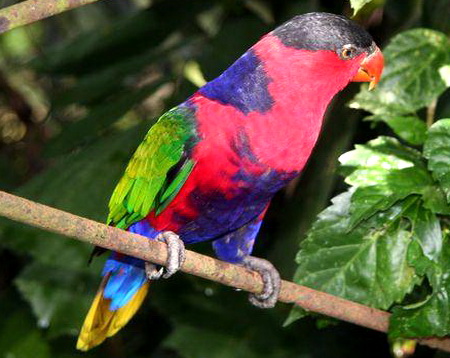
Black-capped lory, orWestern black-capped lory, orTricolored lory(Lorius lory)
Phylum —chordata
Class — aves
Order — psittaciformes
Family — psittaculidae
Genus – lorius
Appearance
Black-capped lories are a medium sized stocky bird with a short, slightly rounded tail, average height about 31cm. They have green wings, red head and upper body, a black cap and blue legs and belly.
Habitat
Black-capped lories is found in New Guinea and adjacent smaller islands.
Behavior
The lory personality is intense, in general. This is not a shy species. The Tricolored lory is bubbly and enthusiastic, the “coach” of the bird world, encouraging play whenever its favorite human is around. These birds are constantly busy and lively, allowing little time for rest. Their antics are extremely entertaining for most people, but they can become a little much for someone that’s used to a more laid-back companion.
Diet
Their diet includes pollen, nectar, flowers, fruit and insects. Black-capped lories have specialized brush-tipped tongues for feeding on nectar and soft fruits. They can feed from the flowers of about 5,000 species of plants and use their specialized tongues to take the nectar. The tip of their tongues have tufts of papillae (extremely fine hairs), which collect nectar and pollen.
Reproduction
The Black-capped lory will roost in the nest year round. Young non breeding birds will roost in the nest year round. Pairs can be extremely aggressive at breeding time. The young can be leg rung at age of 16-18 days.
They have a lifespan of 25 or more years.
In captivity
Black-capped lories are very active and require large cages as well as supervised out-of-cage time. When selecting a cage, it is important to select the largest cage you can afford, remember the bigger the cage the happier the bird. Tricolored lories are very active birds, you will need room for many toys, perches, food/water dishes, as well as sufficient space for them to move around.
Select toys that make noise, such as bells and that they can climb, such as ropes. You will need to provide them items for chewing and branches from trees, such as eucalypts, bottlebrush, acacias or Grevillia’s. Branches should be washed before placed in the cage.
In the wild, the basis of their diet consists of fruits, pollen, insects, seeds, tree blossoms and sometimes even agricultural crops. This rich diet is best reproduced with a commercial seed or pellet based mix that is designed just for lories. They consist of nutritious foods such as oats, millet, sunflower, and other seeds. You should also add a regular dose of fresh fruits and green vegetables.
 Russian
Russian
 English
English























